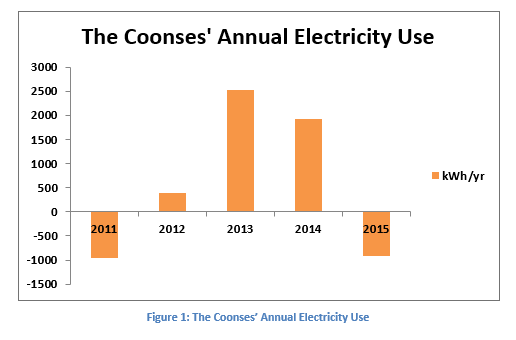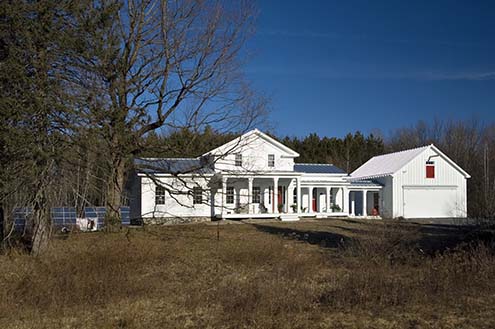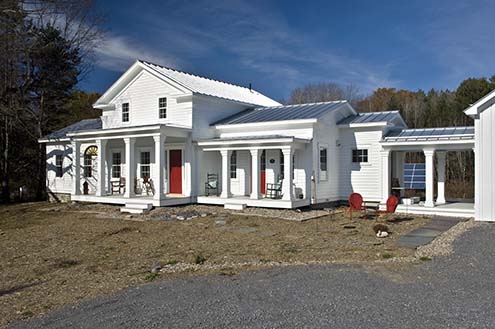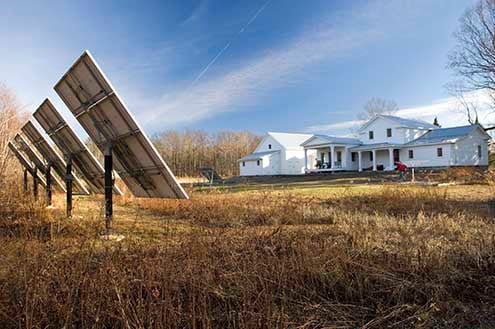Historic Gut Rehab - Paul and Joanne Coons
Home restoration provides an excellent opportunity to bring a residence to the next level—beyond its former glory. Owner-builders Paul and Joanne Coons intended on transforming an 1830s farmhouse into an exceptional, high-performance home. With the help of a qualified team, they put their plan into action. Keeping the 19th century frame, the team set to work implementing modern technology to achieve the net zero energy goal. The Coons’ decided on applying spray foam insulation, installing a metal “cool” roof, and using a Ground Source Heat Pump as part of their energy reduction measures. A solar hot water system and the use of ENERGY STAR® appliances throughout the home were also key components to reaching their objective. By researching and making informed decisions, the Coons’ could achieve a green and high performance home, such that today they have virtually no fuel bills and have even added an electric car charging station.
Project Team Profile
For Paul and Joanne Coons, creating a retirement dream house meant pouring their time and energy into a full gut rehabilitation of an abandoned 1830s Greek Revival farmhouse. By seeking the LEED for Homes Certification and the Certified Homes®New York ENERGY STAR* designation, the Coons' were able to preserve the home’s historic integrity, incorporate green standards, be sustainable and nontoxic, and consume less energy. The result is a stunning, healthy, and comfortable “net zero energy” home—a designation that means it produces the same amount of energy from renewable resources as it uses over the course of a year.
Builder Team
The Coons' enlisted the help of a well-qualified team to complete their net zero energy gut-rehabilitation project:
|
BUILDER/OWNER |
Paul and Joanne Coons |
|
|
ARCHITECT |
(518) 785-5851 |
|
|
HERS RATER |
Karla Butterfield (203) 857-0200 |
|
|
HVAC |
John Ciovacco (518) 885-5383 |
|
|
SOLAR |
Kevin Bailey (518) 209-6727 |
|
|
CERTIFICATION |
NEW YORK ENERGY STAR WaterSense LEED for Home (Platinum) Indoor airPLUS |
|
|
AWARDS |
2011 Clifton Park Historic Renovation Award GreenBuilder Magazine Grand Winner 2012 |
|
*Gut rehabilitation projects are often ineligible to be served by the EPA ENERGY STAR Certified Homes program. They are, however, eligible to receive the New York Energy $mart designation through NYSERDA’s Low-rise Residential New Construction Program.
Net Zero Strategy
The Coonses aspired to build a modern, efficient, net zero energy home while preserving the 19th century shell. They accomplished this with generous insulation, a tight building envelope, a ground source heat pump, efficient appliances, a solar hot water system, and a solar electric system.
When they purchased the home, the existing roof rafters were rough-sawn 4x4s installed at 32” on center. To accommodate for the weight of anticipated snow buildup, the entire roof had to be rebuilt with sturdier rafters. These truss improvements coupled with the replacement of structural columns made it possible to execute the roof plan—which involved the application of spray foam insulation and a modern metal “cool” roof.
The foundation and above-grade walls were also insulated with spray foam insulation. In addition to reducing heat loss and gain though the building shell, spray foam was instrumental in reducing the home’s air-leakage rate. The tested air-leakage rate was at 2.5 ACH 50, which was a very positive result considering the home’s age and layout.
In such tight buildings, fresh air is essential for a healthy indoor environment. To optimize the indoor air quality of their home, the Coonses installed a heat recovery ventilator (HRV). During the heating season, an HRV system extracts heat from air exhausted out of a home and transfers that heat to filtered, fresh air drawn in to the home. In the cooling season, heat from warm fresh air drawn in to the home is cooled by the air exhausted out of the home.
For space conditioning, the Coonses utilized a ground source heat pump (GSHP). A GSHP system is different from a gas-fired furnace with a split central-air conditioning system. First, GSHPs do not burn fossil fuels and use the ground as a heat source and sink. During the summer months, a GSHP extracts heat from the home and pumps (sinks) it into the ground. In the winter months, the heat pump reverses the process and extracts heat from the ground and delivers it into the home. Combining the GSHP system with a variable-speed air-handling unit and a properly designed, well-sealed duct system delivers conditioned air to the living space. GSHPs are up to five times more efficient at converting energy to heat or cool a space than their fossil-fuel burning counterparts, and, because GSHPs are electric systems, they are a great complement to a home with a solar electric system.
Efficient appliances and lighting are other key factors to achieving net zero performance. As a building’s space-conditioning loads are lowered through envelope measures and super-efficient HVAC equipment, lights and appliances represent the lion’s share of the energy consumption. The appliances the Coonses installed are all ENERGY STAR certified and their lighting strategy consisted of a combination of CFL and LED fixtures and bulbs. Additionally, they installed an induction range top and convection oven. The induction range top is cooler to the touch than electric resistance models and uses about 40% less electricity.
The installation of a solar hot water system, rather than an electric or gas water heater, combined with low-flow fixtures significantly reduced their energy use as well. An 8.4 kilowatt (kW) ground mounted solar electric system sufficiently met all their energy needs. In fact, the system initially produced enough excess energy to justify their purchase of two electric vehicles. They bought the first in January, 2012 and when they saw there was still excess electricity, they purchased a second seven months later. In 2013, they provided energy for their neighbors for several months, but in 2014 their household grew, explaining the increased usage for those years as seen in Figure 1. In March of 2015, they added an additional 2.2 kW to their solar electric system to offset their increased energy use.

Economics
Researching building components before awarding bids saved the Coonses money in the long run. For example, the Coonses made the informed decision to install a one-zone heat system based on the size and layout of their home, rather than the proposed two-zone installation. Two zones initially seemed like an attractive choice, but would have added unnecessary cost without additional comfort or energy savings. Planning ahead also saved them from expensive change orders that can occur during home construction.
The Coonses were able to take advantage of various funding sources available at the time of their gut rehabilitation that were significant drivers for this unique project. The historic designation of the home made the project eligible for a Historic Restoration Tax Credit. It also helped generate significant interest within the local municipality, making the planning and approval process faster and more streamlined. Furthermore, the NYSERDA Low-rise Residential New Construction (LRNC) Home Builder Incentive was $1,750 at the time for meeting the standards of the New York ENERGY STAR Certified Homes program. The Coonses also received a $5,000 incentive for meeting the standards of NYSERDA’s Green Residential Building Program (program closed in 2013).
As noted in the Net Zero Strategy section, the Coonses incorporated a solar electric system that produces more energy than their home uses. They use this excess electricity to power their two electric vehicles. To offset the cost of their solar electric system, the Coonses participated in NYSERDA’s NY-Sun Incentive program which offers homeowners a set incentive based on the size of the installed system. Adding solar electric and geothermal systems made the Coonses eligible for a 30% Federal Residential Renewable Energy Tax Credit on the cost of each system, as well as a 25 percent NY State Solar Energy System Equipment Tax Credit for the cost of the solar electric and hot water systems. Last but not least, the Coonses’ efficient home made them eligible for a $2,000 Energy Efficient New Homes Federal Tax Credit.
Overall, the Coonses estimate that their home project cost $130 per square foot exclusive of land. As they set out to build their “forever” home, not only as a coveted Greek Revival restoration in a highly desirable area of Saratoga County, but as a home almost free of utility costs, the Coonses feel positive about their investment in a home that is comfortable and healthy for them and for future generations.
* Please note that tax credit and incentive levels may change due to market transformation trends, changing code requirements, and advancements in technology.
Lessons Learned
Paul Coons believes the home could have achieved its high performance goals with less insulation. The home likely would achieve comparable performance with R-60 roof insulation and R-40 in the walls, attributed to the law of diminishing returns that applies to insulation; the more insulation added, the less effective each additional inch becomes. He also cautions that some soy-based spray foams seem to be susceptible to rodent damage, which may not be appropriate for use in areas easily accessed by these pests.
The Coonses are very fond of their induction range and its performance. They learned decisions about appliances should be based on more than just financial cost—they significantly impact the energy use and indoor air quality of a home.
When choosing contractors, the Coonses advise that owners acquire three bids and look at experience and methodology in addition to price. Working with experienced contractors trained in high-performance building principles can help projects like 4 Balsam Way succeed in reaching their energy goals.
Homeowner Experience
The Coonses feel unburdened and have peace of mind with virtually no fuel bills. They believe the choice to build their home to New York ENERGY STAR Certified Home standards combined with efficient and green products provided them with a durable, comfortable, quiet, and healthy home. Additionally, green certifications like LEED Platinum and EPA’s Indoor airPLUS ensure a holistic environmentally conscious approach and provides superior air quality measures.
Since completion, the Coonses have hosted several tours of their home and even added an electric car charging station to their solar electric system. Their return on investment has increased since purchasing their power systems in 2010, so they advise, “Look ahead, not in front of you” when weighing construction choices.
Pictures, Plans, Materials
Governing Inspector: Town of Clifton Park
Size: 1900 square feet
Stories: 2
Bedrooms: 3
Baths: 2
Climate Zone: 5
HERS Index: Pre-PV: 41, Post PV: 7
Performance Features:
Walls: R-value 48, Composition: 7” high density spray foam; double stud construction
Roof: R-value 100, Composition: 14” high density spray foam
Foundation Walls: Existing aged basement – installed a vapor barrier, 8” foam insulation, air sealing measures
Under Slab: R-20, Composition: 2” of XPS insulation with seams taped
Windows: U-Value .32/.29, SHGC .35/.30 Composition: Historic divided pane windows with exterior and interior storm windows
Air-sealing: ACH50: 2.54 achieved with special attention to sealing around historic windows and air-sealing throughout
Ventilation: Lifebreath HRV
Cooling: System Type: GSHP Efficiency or SEER 27
Heating: System Type: Climatemaster GSHP Coefficient of Performance (COP) 4.9
Hot Water: System Type: Elec tank and VELUX Solar Hot Water Efficiency .94
Lighting: All CFL except for 2 LED fixtures—one in the bathroom, one in the hall
ENERGY STAR-Rated Appliances: Refrigerator, dishwasher
Solar: 8.4kw ground-mounted PV system
Water Conservation Strategy: EPA Water Sense certified
Other:
- New York ENERGY STAR Certified Home
- Indoor Air Plus certified
- LEED Platinum certified




